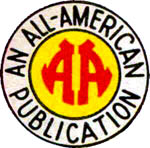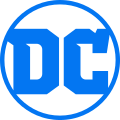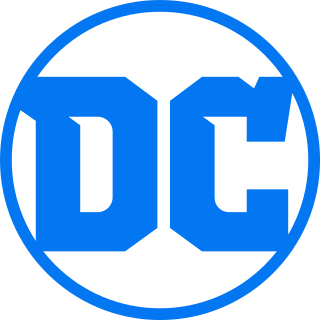
DC Comics, Inc. is an American comic book publisher and the flagship unit of DC Entertainment, a subsidiary of Warner Bros. Discovery.
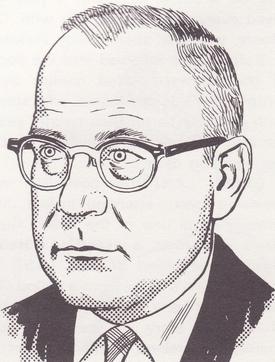
Gardner Francis Cooper Fox was an American writer known best for creating numerous comic book characters for DC Comics. He is estimated to have written more than 4,000 comics stories, including 1,500 for DC Comics. Fox was also a science fiction author and wrote many novels and short stories.

The Justice Society of America (JSA), or Justice Society (JS), is a superhero team appearing in American comic books published by DC Comics. It was conceived by editor Sheldon Mayer and writer Gardner Fox during the Golden Age of Comic Books. It first appeared in All Star Comics #3, making it the first team of superheroes in comic books. Its original members were Doctor Fate, Hourman, the Spectre, Sandman, Atom, the Flash, Green Lantern and Hawkman.
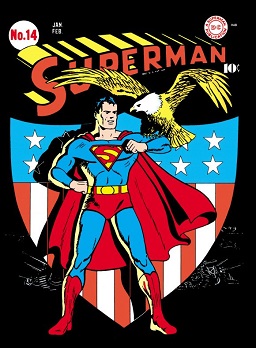
The Golden Age of Comic Books describes an era in the history of American comic books from 1938 to 1956. During this time, modern comic books were first published and rapidly increased in popularity. The superhero archetype was created and many well-known characters were introduced, including Superman, Batman, Robin, Captain Marvel, Captain America, and Wonder Woman.
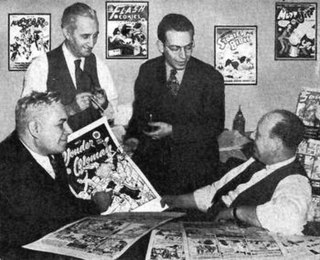
Maxwell Charles Gaines was a pioneering figure in the creation of the modern comic book.

All-American Comics was a comics anthology and the flagship title of comic book publisher All-American Publications, one of the forerunners of DC Comics. It ran for 102 issues from 1939 to 1948. Characters created for the title, including Green Lantern, the Atom, the Red Tornado, Doctor Mid-Nite, and Sargon the Sorcerer, later became mainstays of the DC Comics line.

All Star Comics is an American comic book series from All-American Publications, one of three companies that merged with National Periodical Publications to form the modern-day DC Comics. While the series' cover-logo trademark reads All Star Comics, its copyrighted title as indicated by postal indicia is All-Star Comics, with a hyphen. With the exception of the first two issues, All Star Comics told stories about the adventures of the Justice Society of America, the very first team of superheroes. It also introduced Wonder Woman.
See also: 1964 in comics, 1966 in comics, 1960s in comics and the list of years in comics
Irwin Donenfeld was an American comic book publishing executive for DC Comics. Donenfeld co-owned the firm from 1948 to 1967, holding the positions of Editorial Director (1952–1957) and Executive Vice President. He was the son of Harry Donenfeld, co-founder of the company.
DC Archive Editions is a line of hardcover reprint runs of early, often rare comic book series, titles, and stories which ran from 1989-2014. They include more than 160 Golden Age and Silver Age comic properties currently owned by DC Comics, regardless of whether DC Comics was the original publisher. The series first published Superman Archives Vol. 1 in 1989. Most of the restoration work to make the pages suitable for quality printing has been done by Rick Keene, who has restored more than 2,500 pages.
Notable events of 1940 in comics. See also List of years in comics.

Major Malcolm Wheeler-Nicholson was an American pulp magazine writer and entrepreneur who pioneered the American comic book, publishing the first such periodical consisting solely of original material rather than reprints of newspaper comic strips. Historian and author David Hajdu credits Wheeler-Nicholson as "the link between the pulps and what we know of as comics today." And launching the magazine comics company National Allied Publications in 1934, which would evolve to become DC Comics' later on. He was a 2008 Judges' Choice inductee into the Will Eisner Comic Book Hall of Fame.
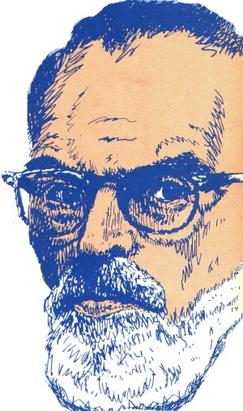
Sheldon Mayer was an American comics artist, writer, and editor. One of the earliest employees of Major Malcolm Wheeler-Nicholson's National Allied Publications, Mayer produced almost all of his comics work for the company that would become known as DC Comics.
Notable events of 1942 in comics. See also List of years in comics.

Harry Donenfeld was an American publisher who is known primarily for being the owner of National Allied Publications, which distributed Detective Comics and Action Comics, the originator publications for the superhero characters Superman and Batman. Donenfeld was also a founder of the Albert Einstein College of Medicine.

Ira Schnapp was a logo designer and letterer who brought his classic and art deco design styles to DC Comics beginning with the redesign of the Superman logo in 1940. He did a great deal of logo and lettering work for the company in the 1940s. Around 1949, he joined the staff as their in-house logo, cover lettering and house-ad designer and letterer, and continued in that role until about 1967.

Jacob S. Liebowitz was an American accountant and publisher, known primarily as the co-owner with Harry Donenfeld of National Allied Publications.
Independent News Co. was a magazine and comic book distribution business owned by National Periodical Publications, the parent company of DC Comics. Independent News distributed all DC publications, as well as those of a few rival publishers, such as Marvel Comics from 1957 to 1969, in addition to pulp and popular magazines. The company was founded in 1932 and operated until c. 1970.
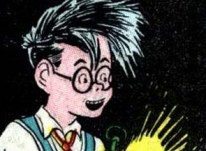
Scribbly the Boy Cartoonist is a comic book character created in 1936 by Sheldon Mayer, first appearing in Dell Comics and then moving to All-American Publications. Scribbly Jibbet is a semi-autobiographical character, presenting the adventures of a young man starting out in the cartooning business, and working for the Morning Dispatch newspaper. His stories were told around the Golden Age era, when American Comic Books were primarily anthologies telling more than one story in a magazine issue. Scribbly first appeared in the Popular Comics series, and then appeared in All-American Comics from 1939 to 1944. He was then revived in his own series, Scribbly, from 1948 to 1952.
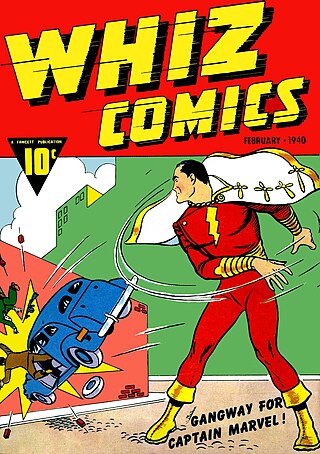
The 1940s were an essential time for DC Comics. Both National Comics Publications and All-American Publications would introduce many new featured superheroes in American comic books in superhero comics anthology tales like More Fun Comics, Adventure Comics, Detective Comics, Action Comics, All-American Comics, Superman, Flash Comics, Batman, All Star Comics, World's Finest Comics, All-Flash, Star Spangled Comics, Green Lantern, Leading Comics, Sensation Comics, Wonder Woman, Comic Cavalcade and Superboy that would be a staple for the comic book company. Examples of the superheroes include the Flash, Hawkman and Hawkgirl, Johnny Thunder and Thunderbolt, Spectre, Hourman, Robin, Doctor Fate, Congo Bill, Green Lantern, Atom, Manhunter, Doctor Mid-Nite, Sargon the Sorcerer, Starman, Johnny Quick, the Shining Knight, the Star-Spangled Kid and Stripesy, Tarantula, Vigilante, Green Arrow and Speedy, Aquaman, Wonder Woman, Sandy, the Golden Boy, Mister Terrific, Wildcat, Air Wave, Guardian, Robotman, TNT and Dan the Dyna-Mite, Liberty Belle, Superboy and Black Canary. These characters would later crossover in superhero team titles in the 1940s such as the Justice Society of America and the Seven Soldiers of Victory helping pave a way to a shared universe of the publication company. Other used featured characters outside of superheroes included kid titular heroes like the Newsboy Legion and the Boy Commandos. Later Western heroes would be used such as Johnny Thunder, Nighthawk and Pow Wow Smith.
